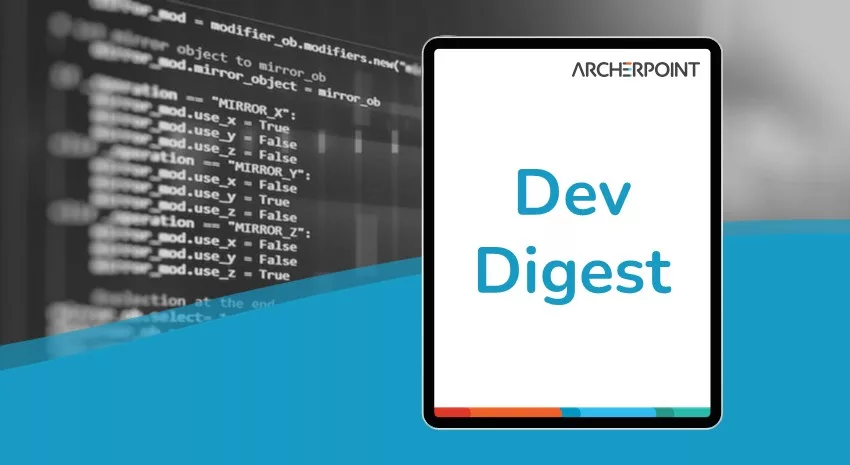ArcherPoint Microsoft Dynamics NAV Developer Digest - vol 25

The ArcherPoint technical staff—made up of developers, project managers, and consultants – is constantly communicating internally, with the goal of sharing helpful information with one another.
As they run into issues and questions, find the answers, and make new discoveries, they post them companywide on Yammer for everyone’s benefit. We in Marketing watch these interactions and never cease to be amazed by the creativity, dedication, and brainpower we’re so fortunate to have in this group—so we thought, wouldn’t it be great to share them with the rest of the Microsoft Dynamics NAV Community? So, the ArcherPoint Microsoft Dynamics NAV Developer Digest was born. Each week, we present a collection of thoughts and findings from the ArcherPoint staff. We hope these insights will benefit you, too.
Michael Heydasch on backing up your backing up your Windows 8.1 installation:
I used to regularly make emergency repair CD/DVD boot disks for my Windows laptops by right-mouse-clicking on My Computer, selecting Properties, System protection, and Create Emergency Repair Disk. Microsoft has removed this ability in Windows 8.1. In this post I’ll describe two (2) options you can use to backup your Windows installation should it become corrupt. Option 1 is to create a system image. Whatever drive you use to store the system image has to have enough available space to make a copy of the Windows installation drive. Assuming your Windows installation drive is C: and is sized 200G, and you have a second hard disk or an external USB drive (D: for example), you must ensure drive D: has at least 200G free.
Launch Powershell (%SystemRoot%system32WindowsPowerShellv1.0powershell.exe) as Administrator and execute the following command to create a system image of your Windows installation drive: “wbAdmin start backup -backupTarget:D: -include:C: -allCritical -quiet” Then, in a recovery situation, when booting from the Windows install media or from the recovery partition, you’ll have an option to “Repair Windows” and to select the system image previously backed up.
Option 2 is to create a USB recovery drive, which will delete everything on the USB drive. Ensure you have enough room on the USB drive to make an image of the Windows installation drive. Use Windows search and enter the keywords “recovery drive” to start this process.
Question on invoicing a drop ship purchase order without the corresponding drop ship sales order:
Question: Out of the box in NAV, you can’t invoice a drop ship purchase order until the corresponding drop ship sales order has been invoiced. I’ve got a request from a customer to disable this functionality, and it looks like putting that code in place really isn’t too difficult. However, I want to make sure there’s not a compelling business reason for this block before I make the changes. So, why can’t you invoice a drop ship purchase order before invoicing the drop ship sales order?
Answers:
Tom Marshello
I think the only reason is to insure that you get your invoice out to the customer before you pay your vendor. I can’t think of any other reason why.
Helle Madsen
Tom Marshello , you’re right. It was to be sure that you don’t forget to invoice the customer, because in many cases you don’t even know that the product has been shipped, and it was assumed that the vendor will not forget to invoice you.
Scott Peetz
I would just be careful to understand why the sales order isn’t invoiced before they process the purchase invoice. If, for whatever reason, it’s possible that they process a purchase invoice for 100 units but the customer says they only received 90 prior to invoicing then you could have trouble – especially in situations where EDI is involved. To fix this you’ll have to create a sales invoice for 100 units and a sales credit memo for 10 units to correct the problem. In some industries that will impact vendor scorecard metrics or even incur a non-compliance fine (chargeback). There are solutions and work arounds to this (e.g. one invoice for 90 units and one for 10) but it really depends on the risk of headaches in the end.
Michael Heydasch shared an article on mixing Waterfall and Agile approaches to software development:
Mixing Agile with Waterfall for Code Quality
ArcherPoint uses the Agile methodology in software design. As a convert from the Waterfall school of thought, I missed the up-front design work in crafting the ideal design and architecture, but have also learned to embrace the ability to adjust that design as new requirements come in – everything from change requests from clients who forgot necessary specs to industry demands for new technology requirements This article points out that the combination of the two approaches provides better code than either approach alone.
From the article:
“Consistently across all the structural quality characteristics—Robustness, Performance Efficiency, Security, Changeability, etc.—the mix of Agile and Waterfall methods had significantly higher scores…Good structural quality was most often observed when the early architectural analysis characteristic of Waterfall methods was combined with continual testing of the emerging software in Agile sprints.”
Alan Campbell on conventional vs change agent approaches for the Business Analysis:
In comparing the two versions of the BABOK, we find this change in the definition of Business Analysis:
BABOK v2 – “Business Analysis is the set of tasks and techniques used to work as a liaison amount stakeholders in order to understand the structure, policies, and operations of an organization, and to recommend solutions that enable the organization to achieve its goals.”
BABOK v3 – “Business analysis is the practice of enabling change in an enterprise by defining needs and recommending solutions that deliver value to the stakeholders. Business analysis ultimately helps organizations to understand the needs of the enterprise and why they want to create change, design possible solutions, and describe how those solutions can deliver value. “
Trending Posts
Stay Informed
Choose Your Preferences
"*required" indicates required fields
